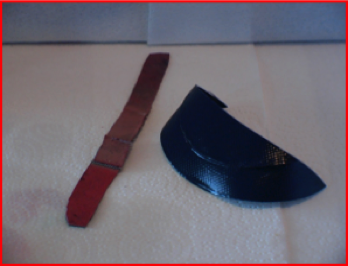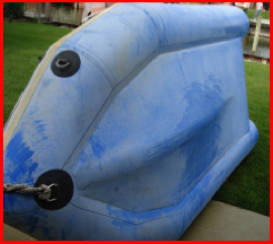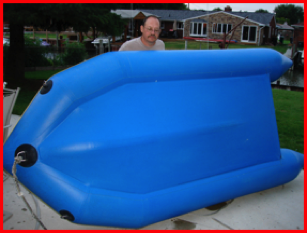TYPES OF FABRIC USED TO MAKE INFLATABLE BOATS
Inflatable Boat Fabrics (see HERE for more details):
The least expensive inflatable boats are constructed from polyvinylchoride (PVC, “vinyl”) often with welded seams, using automated processes that reduce labor costs.
Traditionally, high quality boats have been manufactured from a type of synthetic rubber called Hypalon® but all seams have to be glued by hand after sanding (to remove surface silicones from the rolling process), incurring significant labor costs. Recently, polyurethane fabrics have been introduced that have superior puncture and abrasive resistance; the seams can be glued OR welded.
More recently, vinyl has been improved in a copolymer as Elvaloy®, a fabric that can be glued or welded but without the plasticizer migration problems of regular vinyl (see below).
In each case, the material is “calendered” as a sandwich on each side of a woven fabric backing. We have over 15 years of extensive field experience with vinyl and hypalon but not yet with the newer fabrics.
Rigid Inflatable Boats (“RIBS”) have the bottom portion of the hull in rigid form that gives better planing and directional stability. The gelcoated fiberglass of the lower portion of such boats can be maintained from new, as described HERE or restored as described HERE.
Neglected Vinyl Breaks down as shown HERE
The enemy of all plastics, especially vinyl, is abrasion and the UV/ heat of direct sunlight, together with air pollution containing ozone and hydrocarbons (from refineries, airplanes, car or boat exhaust). Together, these conditions cause migration of plasticizer to the surface (seen as gummy stickiness). This may be closely followed by oxidative breakdown of the vinyl, seen as yellowing and stiffness, eventually leading to a chalky surface and brittleness. Other problems include staining of the vinyl from spills or from mildew or algae. Stickiness is seen particularly on the older vinyl boats (Zodiac, West Marine and Quicksilver). Our products can help prevent these problems and can restore boats that have become “sticky”. However, if cross-linking of the vinyl chains has occurred, then the vinyl is probably too brittle to be successfully restored.
Hypalon® breaks down as shown HERE
Originally developed by Dupont, this material (chlorosulfonated polyethylene) looks and feels like rubber. It is very resistant to weathering or abrasion, as well as to gasoline, and most solvents except toluene, benzene and xylene. The only time toluene should be used on this material is to clean and melt some of the surface before glueing.
The fabric is glued together, after sanding and partially melting the surface by using a two-part catalyzed adhesive. While hypalon boats are more expensive than those constructed of vinyl, they will outlast them by many years. The hypalon is calendered (molded onto) a woven fabric base, sometimes over a neoprene inner layer.
Hypalon is porous to stains (e.g. diesel soot).- one good reason for sealing the surface with SILKENSEAL™ Small plastic fittings and underfoot hull areas can receive an additional coating of NON-SLIP Superglaze™. Barnacles "eat" hypalon, so avoid prolonged (month or more) immersion in sea-water.
Polyurethane fabric:
This is a newer inflatable fabric, originally formulated in the 1960s for use in portable aviation fuel bladders and so is resistant to many chemicals. It has the slick feel of vinyl, with the toughness of hypalon but is much more puncture resistant and resistant to abrasion & stains. It is less flexible than hypalon and there have been reports of color fade. However, It does not become gummy or break down to a chalky surface in the same way as vinyl or hypalon. Seams can be glued or welded. Click HERE for more information.
Elvaloy® :
This is a high molecular weight polymer, classified as an ethylene interpolymer alloy, It acts as a toughener
and as a flex-agent when compounded into other polymers. Unlike conventional plasticizers used in PVC, Elvaloy® does not migrate to the surface and therefore is not lost through evaporation or extraction. When formulated with vinyl, the result is an outstanding inflatable boat fabric that fights weathering and chemical attacks. The fabric has a soft feeling and permanent flexibility while its abrasion resistance is very high. Seams can be both welded or glued. Click HERE for more information.

CLEANING & RESTORATION OF NEGLECTED DINGHIES
First wash the boat to remove surface dirt. You can use any detergent in water, but well water-diluted IG Pink™ is particularly effective.
On inflatable boats made of heavy duty vinyl or hypalon, our Cleanser/ Conditioners may be used directly at full strength using a 3M Synthetic Steel Wool Pad (Grey, "000" grade) to help remove stains and to impregnate the fabric with preservative conditioner. NEUTRAL CLEAR™ can be used on any color, but is best on “earth tone" colors ( beige, cream brown etc) since it will not alter the color. SEA GLOW™ is best for white but can also be used on blue, red and other bright colors of fabric. Either product can be used on grey or black).
After neutralizing the cleanser by water-wiping and then toweling dry, seal the surface with SILKENSEAL™ . The fabric will again become bright and "new" looking with a protective surface sheen.
Treat Polyurethane fabric more like vinyl (avoid heavy abrasion during cleaning, using only a 3M White scuff pad ("0000" grade) and/or white paper towel. To avoid slipperiness when clambering in and out of the dingy, the top of the inflatable tubes may receive a coat of NON-SLIP Superglaze™ applied over a SILKENSEAL™ undercoat.



A: COMMISIONING A NEW INFLATABLE BOAT
1. Using white paper towel or microfiber cloth, very sparingly wipe over the fabric surfaces of the dinghy with an appropriate Cleanser-Conditioner. Use NEUTRAL CLEAR™ for any color of inflatable fabric, but it is especially suitable for "earthtone" colors such as beige, grey, cream, and brown. SEA GLOW™ is absolutely the best product to use on white boats, but it can also be used on yellow, red, blue or any other "bright" colors. It should NOT be used on earthtone colors since it will abnormally change the color in a blotchy pattern, depending upon how much it has soaked in.
These Cleanser-Conditioners will impregrate the fabric with conditioners that enhance and maintain suppleness and protect agains color fade, oxidation, mildew or algae. The strong fluorescent blue properties of SEA GLOW™ are especially effective in maintaining snowy whiteness of the inflatable fabric, as we have seen for many years on both vinyl and hypalon,
2. Next wipe the boat over with water-wetted paper towel and then towel dry,
3. Finally, seal the surface against stains and abrasion with SILKENSEAL™ "plastic skin" surface protectant. After it is dry to the touch, a second coat may be applied. On underfoot areas that can be slippery when wet (upper surface of the tubes), a coating of NON-SLIP Superglaze™ can be applied over the SILKENEAL™ undercoat. This product can also be used to protect metal and hard plastic parts, although MIRROR HARD Superglaze™ is a little more protective since one wipe gives a thicker coating.
B: ROUTINE CARE AND MAINTENANCE
Inflatable boat fabric (especially vinyl) is very sensitive to UV, airborne pollutants and abrasion.Therefore:
1. Keep the boat covered or inside whenever not in use.
2. Routinely rinse off the dinghy with fresh water at intervals so that airborne soot and pollutants do not have time to accumulate and start to penetrate the protective layer of SILKENSEAL™
Light Cleaning; Use copiously water-diluted ISLAND GIRL PInk™. Start with a few squirts into a bucket of water. Alternatively dish soap (less effective) can be used.
Be as gentle as possible while cleaning. Just use soft brushes, microfiber cloth or white paper towel. The white 3M scuff pads ("0000" grade) are also suitable for stubborn grime. Reapply SILKENSEAL™ and/or NON-Slip Superglaze™ if water beading seems diminished.
Moderate Cleaning: Use a 20-50% water dilution of ISLAND GIRL Pink™ . Then rinse well with water and towel dry before resealing the surface with SILKENSEAL™ then (optional) NON-SLIP Superglaze™ on tops of the tubes).
Safety of our Products:
We have done prolonged “soak tests” of inflatable boat seams with our products (ISLAND GIRL Pink™, , NEUTRAL CLEAR™ and SILKENSEAL™ ) both with glued and welded vinyl and glued hypalon. In addition we have used our Cleansers and SILKENEAL™ over a ten year period before glueing on a new “splash apron”on our Tinker dinghy. Properly preparing the surface ( Ajax™ cleaner, then deep sanding, partially melting the surface with toluene). resulted in excellent adhesion to a joint that has lasted for over 12 years (2-part adhesive)
SEA GLOW™, Then SILKENSEAL™
At left: A hypalon inflatable seam after 7 years soaking in NEUTRAL CLEAR™ Cleanser-Conditioner .Also shown is a blue vinyl glued seam after almost one year of similar soaking.A video on inflatable dinghies is show below.